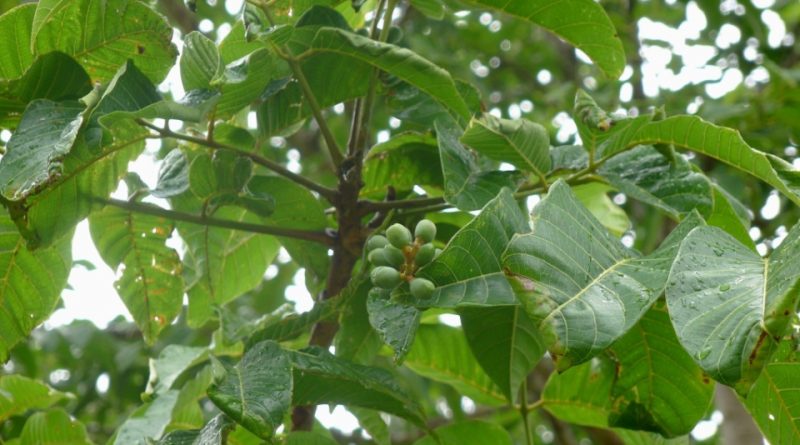Canarium luzonicum
Canarium luzonicum
The Elemi (Canarium luzonicum (Blume) A.Gray) is an arboreal species belonging to the Burseraceae family.
Systematic –
From a systematic point of view it belongs to the Eukaryota Domain, Kingdom Plantae, Magnoliophyta Division, Magnoliopsida Class, Sapindales Order, Burseraceae Family and therefore to the Genus Canarium and to the C. luzonicum Species.
The terms are synonymous:
– Canarium carapifolium G.Perkins;
– Canarium oliganth Merr .;
– Canarium polyanthum G.Perkins;
– Canarium triandrum Engl .;
– Pimela luzonica Blume.
Etymology –
The term Canarium comes from kanari or kenari, its Malay vernacular name.
The specific epithet luzonicum is of unknown origin.
Geographical Distribution and Habitat –
The Canarium luzonicum is a tree native to the Philippines where it is threatened by the destruction of the habitat which is represented by the lowland rainforests and primary forests at low and medium altitudes.
It is classified as “vulnerable” on the IUCN Red List of Threatened Species.
Description –
Elemi is a large dioecious evergreen tree, which can reach a height of over 30 meters with a trunk that can be one meter or more in diameter.
The leaves are alternate, pinnate and about 30 centimeters long, commonly with three opposite pairs and a terminal flyer.
The leaflets are smooth, oblong-ovate, 12 to 20 centimeters long, 3 to 7 centimeters wide, smooth and shiny on both sides, pointed at the apex, rounded or obtuse at the base.
The flowers are grouped and carried on large compound inflorescences.
The plant is pollinated by insects.
The fruit is ovoid in shape, 4 to 5 centimeters long, 2 to 2.5 centimeters wide, smooth, with only one seed.
Cultivation –
The Canarium luzonicum tree is widely collected in nature by the local population and is also occasionally grown for its resin and edible seeds.
A single tree produces 4-5 pounds of resin.
Wild forms usually have three, sometimes two kernels present in the walnut, each in its compartment. In the case of cultivated trees, however, sometimes there is only one core in each nut; in this case, the kernel is proportionally larger.
Trees are dioecious, both male and female forms must be grown together if fruit and seeds are to be obtained.
As far as propagation is concerned, there is no detailed technical information, but the seeds of this genus generally have a hard coat and sprout irregularly. For this reason, however, a preliminary scarification of the seed coat is necessary to allow moisture to penetrate more easily and promote faster and more uniform germination.
Uses and Traditions –
From the resin of this plant (obtained by incisions in the bark) an essential oil (elem oil from Manila) is obtained by distillation which has a long history as a medicinal use.
It is considered antibacterial, antifungal, antirheumatic, antiseptic, antispasmodic and rubefactory.
A study on the composition of Manila elemi oil verified the presence of 39 compounds, with limonene being the most abundant with 56%. The constituents include, in addition to limonene, phenandrene, elemolo, elemicina, terpineol, carvone and terpinolene.
Oleoresin is applied externally to the joints; it is used for arthritic and rheumatic pathologies, boils, abscesses, boils, burns and sores. It is heated and applied to the chest as a poultice to stop a severe cough.
The resin of the Elemi is soft and fragrant, oily, light yellow to greenish in color, with a honey consistency, with a balsamic smell and a bitter taste.
It is used in paints and inks; for caulking boats; torches; perfumery and for various medicinal applications.
It can be used for the same purposes as turpentine.
Tree bark is commonly used for postpartum baths.
Essential oil is an ingredient in a commercial preparation called “Lysout”, a natural anti-lice foaming gel that also contains Echinacea purpurea.
Fair quality tannins are obtained from the bark.
The wood is not very hard and is used for light constructions.
This species is one of the sources of the kedondong timber, which is obtained from several species of the Burseraceae family.
However, the tree is most valued for its resin and edible seeds and is therefore poorly harvested for its wood.
The word elemi has been used several times to indicate different resins. In the seventeenth and eighteenth centuries, the term generally indicated a resin from trees of the Icica genus in Brazil, and previously represented the resin derived from Boswellia frereana. The word, like the old term animi, seems to be derived from enhaemon (εναιμον): the name of a styptic medicine called by Pliny to contain the tears that oozed from the olive tree of Arabia.
The name Elemi derives from an Arabic phrase which means “above and below”, an abbreviation of “As above, so below” and this tells us something about its action on the emotional and spiritual planes. ”
Method of Preparation –
Various uses can be made of the Canarium luzonicum for edible purposes.
The seeds can be eaten cooked or raw. They taste delicious when roasted and served like almonds.
They can also be used in packaging, ice cream, nut milk etc. and as chocolate adulterants.
The coat surrounding the core should be removed as it can cause diarrhea.
A sweet oil obtained from the seed is used for cooking.
The fruit pulp is boiled and eaten.
An oil can be extracted from the fruit pulp and has a spicy flavor, similar to resin.
Guido Bissanti
Sources
– Acta Plantarum – Flora of the Italian Regions.
– Wikipedia, the free encyclopedia.
– Treben M., 2000. Health from the Lord’s Pharmacy, Tips and experiences with medicinal herbs, Ennsthaler Editore
– Pignatti S., 1982. Flora of Italy, Edagricole, Bologna.
– Conti F., Abbate G., Alessandrini A., Blasi C. (edited by), 2005. An annotated checklist of the Italian vascular flora, Palombi Editore.
Warning: Pharmaceutical applications and alimurgical uses are indicated for information purposes only, they do not in any way represent a medical prescription; therefore, no responsibility is accepted for their use for healing, aesthetic or food purposes.


